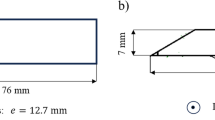Abstract
In high-speed cutting of hardened steels, the surface layer is strongly affected by thermal effects and mechanical forces. Due to this, the surface layer of the machined material changes noticeably. Microhardness, one parameter of the surface integrity, is the most important. This paper deals with an investigation of microhardness. Measuring results are presented, and reasons for the sometimes significant changes in microhardness are analysed. It is proved on which part of the cutting edge the material removal will not take place but the cutting edge deforms the material plastically and how this part of the cutting edge can be reduced. With the measurement of the cutting force, the hypothesis is proved that the values of the cutting force components related to each other are different compared to the traditional turning. The passive force is 1.88–2.25 times higher than the main cutting force. Hence, the force taking place on the flank face of the cutting tool is very high and the friction power significantly influences the cutting temperature. The friction taking place on the flank face of the cutting tool generates 2.8–3.9 times higher heat than the cutting force. Due to the changes that occur in the surface layer, the hardness of this layer is higher with 100–150 HV in depth of 0.1 mm than the original hardness or the hardness prescribed in the technical drawings. This phenomenon can be observed not only in internal hard turning but also machining of external and conical surfaces. Microhardness is compared after hard turning and after grinding. According to the measurements, the ground surface has not become a harder surface layer but softer. As an average result of many measurements, it has been proven that the original hardness (700 HV) after case hardening will increase to 800–850 HV after hard turning and will decrease to 500–550 HV after grinding. Microhardness changes are analysed considering the typical chip removal characteristics of hard turning. In this article, the focus is on how changes in microhardness influence the functional behaviour of the components and may affect their lifetimes. In this article, it has been proven that independently from the surface of the machined gear (bore, conical or face surface) the changes in the surface layer regarding microhardness do not differ.
Similar content being viewed by others
References
Rech J, Moisan A (2002) Surface integrity in finish hard turning of case-hardened steels application to gear cane brakes. Proc. of the International Conference on Manufacturing Engineering. Haikidiki, pp. 195–203
Abrao AM, Aspinwall DK The surface integrity of turned and ground hardened bearing steel, Wear 196: 279–284
Schmidt J Mechanische und thermische Wirkungen beim Drehen gehärteter Stähle. Berichte aus dem Institut für Fertigungstechnik und spänende Werkzeugmaschine. Universität Hannover Reihe 2. Nr. 519
Wobker HG (1997) Hartbearbeitung, Habilitation thesis. Uni-Hannover
Jaeger JC (1942) Moving sources of heat and the temperature at sliding contact. Proc of the Roy Soc New S Wales 76(3):203–224
Tönshoff HK, Arendt C, Ben Amor R (2000) Cutting of hardened steel. Annals of the CIRP 49(2):547–566
Schmidt J (1999) Mechanische und thermische Werkungen beim Drehen gehärteter Stähle. PhD Dissertation, Universität Hannover
Kundrák J Bana V (2005) Surface integrity of hardened bores Proc. on the microCAD´2005 International Scientific Conference, Section M: Production Engineering and Manufacturing Systems Miskolc, Hungary, pp. 89–96
Brinksmajer E, Brockhoff T (1994) Randschicht-wärmebehandlung durch schleifen. Härterei-Technische Mitteilungen 49:5327–330
Shaw MC, Vyas A (1994) Heat affected zones in grinding steels. Annals of the CIRP 43(1):279–282
Rose A (1966) Eigenspannung als ergebnis von wärmebehandlung und umwandlungsverhalten. HtM 21(1):150–164
Bana V, Karpuschewski B, Kundrák J, Hoogstrate AM (2007) Thermal distortions in the machining of small bores. J Mater Process Technol 191:335–33
Brinksmeier Brockhoff (1999) White layers in machining steels. 2nd International Conference on High Speed Machining, Darmstadt, pp. 7–13
Tönshoff HK, Karpuschewski B, Borbe C (1998) Hard machining—state of research. Proc. Of the Intern. CIRP/VDI-Conf. High-Performance Tools, Düsseldorf, pp 253–277
Beno J (1999) Teória rezania kovov (Theory of metal cutting) Kosice 250
Author information
Authors and Affiliations
Corresponding author
Rights and permissions
About this article
Cite this article
Kundrak, J., Mamalis, A.G., Gyani, K. et al. Surface layer microhardness changes with high-speed turning of hardened steels. Int J Adv Manuf Technol 53, 105–112 (2011). https://doi.org/10.1007/s00170-010-2840-y
Received:
Accepted:
Published:
Issue Date:
DOI: https://doi.org/10.1007/s00170-010-2840-y




